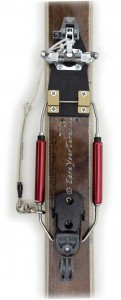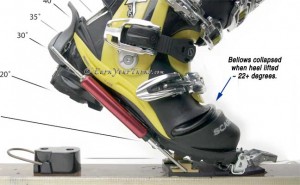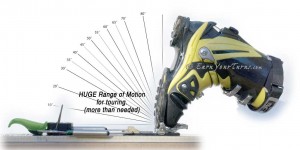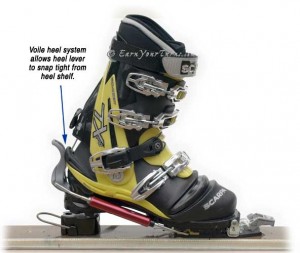
Dynafiddle Toe + Voile cable w/radical pivot location
+ Hammerheel. 2¼ lbs. per pair.
Click to enlarge.
Step 1: Squishing out some more room with toe caps via heat molding.
Step 2: Add some foam above my instep to help hold my heel in place, a necessary measure to balance the massive amount of resistance created by the super active pivot position of the TTS cable.
Step 3: The Targa heel throw had to go. The easiest solution was to substitute a Voile cable assembly for the G3. This was simple, and did the trick beautifully. Because of how aggressive the pivot location is pretension was set to minimal. It was enough to hold the heel lever tight and let me use the full range of Voile’s more linear spring compression.
Testing: Day 2
Next stop, Sugar Bowl ski resort, where the crowds aren’t too big, and you can use a lift or two to warm up before launching into the surrounding backcountry. The first two runs on groomers revealed the troubles with my inaugural run on the TTS binding were indeed the result of poor optimization. Driving the rear ski with lots of edge control was as good as I’ve ever experienced. I’ll have to do a side by side comparison with an NTN binding to confirm, but based on memory—at the worst—the TTS was on par with NTN, Axl, or Hammerhead for skiing power (see Verdict on TTS for that confirmation).
Out of bounds the inconsistencies of an unconsolidated snowpack were exacerbated by skiing with relatively small sticks and excess power under the bellows. When I hit grippy patches of wind buff broiled by the sun I would pitch forward causing the boot to compress to it’s limit but my knee was still at least six inches above the deck. It would not bend lower. I don’t know if that was the springs hitting their limit, or the boot refusing to bend at the cuff any further (the bellows had long since been fully compressed). Probably both.
Like its competitor, NTN, if you like to get low in your tele stance, the TTS will prevent you from achieving that. Those who tele more upright will love it. Lengel has mentioned plans to offer longer springs to allow a larger range of motion while turning.
Although I appreciated the extra control in variable conditions, I would have preferred a lower power setting, especially for a ski that was only 86mm at the waist. I have little doubt that I would embrace the level of power TTS delivered even more if I was driving a bigger rig and had more need of it. As it is, I’m very used to driving a ski in the mid-80mm range with Voile’s Switchback. That’s a dramatic shift, like going from HH 2½ to what feels like HH5+, maybe HH6+.
As ever, it is easier to adapt to harnessing more power than finessing your way with less. Even so, there are plans to offer a version with multiple cable pivot locations for fine tuning the power available.
So what is the bottom line here?
There is no question, Tech bindings (aka Dynafit) are not just the binding platform of choice for ski mountaineers with locked heels, but those with a tele-style free heel too. And just as trusting your legs to a Dynafit toe requires a certain measure of faith even with training heels, it is no less true with a permanently free heel either. The results are similar too.
It was a joy to skin up with Dynafit’s, but I must say, by comparison, I can still get into my Switchbacks faster and I don’t notice a lot of difference in uphill efficiency due to less weight or a potentially longer stride, because neither were evident in my particular mix of skis, boots and bindings. Over time I’m sure I’ll adapt my transition moves so it is as efficient as my current procedure.
I did manage to release out of the toes once on a climb because on this particular pair of bindings I couldn’t lock out the release due to some tolerance issues on the custom base plate. On this particular set up dimples from a prior binding mount pushed through the machined baseplate preventing me from pulling up on the lock out lever. Wasatch plans to make an injection molded baseplate for the production version to limit the effect of ski surface dimples from interfering with operation of the toe lockout.
The main reason I didn’t notice much difference in skinning efficiency between the TTS and a Switchback was mostly due to the boots. To date, most NTN boots are designed with the emphasis on downhill performance, most evident in universally tall cuffs regardless of manufacturer. But the real killer for touring efficiency with these boots, besides their weight, is the lack of backward movement of the cuff.
It would be nice if someone would make an NTN teleboot that had a cuff which could bend backwards like the Dalbello boots do, or Dynafits’ and Scarpa’s rando race boots, but also has two positions for skiing: 1) A fully forward lean position for aggro telemarkers and 2) a position that allows a large minority of us who like to ski in walk mode with a free floating cuff, but don’t want the cuff to move backwards past vertical.
I don’t know if this is a typical response with Dynafit bindings, but I did notice that the heel of my ski naturally dropped when doing a simple kick turn, so I didn’t have to snap the ski around at most switchbacks. When I did try a snap, I had to be careful not to snap too hard lest I kick the tip of the ski into my crotch.
Mark Lengel was savvy enough to outfit the TTS binding with a Hammerheel, my current favorite telemark climbing peg. The spring-loaded climbing peg snaps down, holding the heel lever in place when carrying your skis, or when skinning uphill in free-pivot mode. When you feel the need for climbing stilts, the climbing peg is easily flipped up just by tugging at it with a pole handle, or basket.
The question on many people’s minds, does TTS release?
Theoretically, yes.
Depending on what toe you chose for your TTS system, a release is possible, though I’ll speculate it is unlikely except in rare circumstances. The TTS comes with a choice of a Dynafit toe, with a release value comparable to DIN 13, or a Ski Trab Tech Toe with a DIN 11 rating. For most cases, this is strong enough to hold your boot without letting go prematurely, but might release in an egg beater fall. In my limited use of TTS so far, it didn’t release, nor should it have, so it passes my test for premature release. So far that is.
Availability
When will the TTS be available? Now, in limited quantities, as a beta binding. The price for dropping almost a pound per binding and increasing the touring range of motion to over 90°, and maintaining equal or greater downhill power is — compared to Rottefella’s NTN — a reduction in the ease of getting in and out of the binding, the loss of a ski brake (for the moment), and arguable releasability.
To obtain a pair you must part with $375 Federal Reserve notes for the Dynafit toe, or $475 for a Ski Trab TR RAce toe (approx. ¼ pound lighter with an easier, more elastic release). If you already have a Dynafit toe, talk to Mark about obtaining an adaptor kit. Contact him via email at info@wasatchski.com.
In any case, remember, this is a beta binding. Part of the deal is it is a work in progress, and you’re paying for the privilege of being on the test team. The benefit is you will have real input on the outcome and success of this binding, and be first in line for the “final” version.
I know there are a few others out there who have experience with this binding. Love to hear your comments below. Have questions? Fire away.
Related articles: Day 1 with TTS • Verdict on TTS • Faith required w/TTS
© 2011




10 pings
Skip to comment form
[…] Posts: Verdict on Telemark Tech System Dynafit goes bi-sensual Day 2 on TTS Day 1 on […]
[…] the two months since my last report on the performance of the new TTS binding they’ve been put through a fairly thorough gauntlet […]
[…] look at why. Dostie took the perfect picture of the problem and commented on it briefly in his TTS review so we’ll look at that for […]